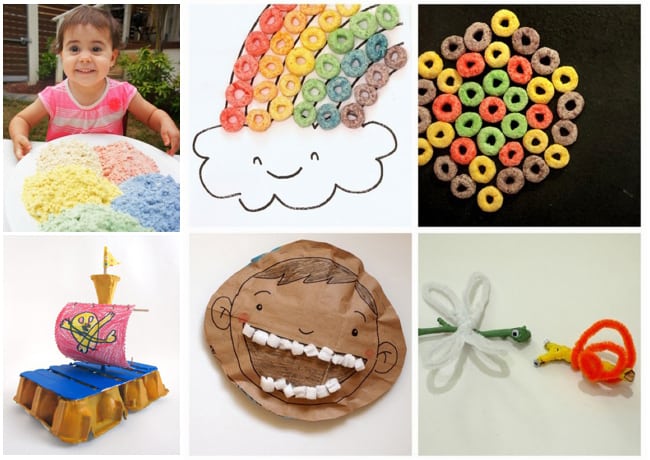Unleash Your Toddler’s Creativity with Fun Craft Activities for 3-Year-Olds!
Welcome to our joyful corner of crafting ideas where your little one’s imagination can run wild! As parents, we’re always on the lookout for ways to encourage our children’s development, and what better way to do so than with engaging craft activities that are perfect for 3-year-olds? In this guide, you’ll uncover a treasure trove of creative activities that not only keeps tiny hands busy but fosters essential developmental skills, too!
Benefits of Crafting with Your Toddler
Before diving into the fun, let’s understand why craft activities are so beneficial for young children. Crafting can:
- Enhance fine motor skills: As your three-year-old grips crayons, scissors, or modeling clay, they’re improving their dexterity and hand-eye coordination.
- Boost creativity and imagination: Crafts enable kids to express themselves and let their imagination soar, laying the groundwork for innovative thinking.
- Promote cognitive development: Activities like sorting beads or constructing paper projects encourage problem-solving and spatial awareness.
- Encourage following instructions: Simple, step-by-step activities help kids learn the importance of following directions to achieve a desired outcome.
- Teach patience and perseverance: Sitting down to complete a craft project can teach kids the value of patience and the reward of seeing a task through to completion.
Preparing for Craft Time – A Checklist
Before you embark on your crafting journey, make sure you’re all set to encourage a mess-free, stress-free creative experience:
- Gather your materials: Stock up on age-appropriate items like safety scissors, non-toxic glue, washable paints, and large beads.
- Crafting space: Designate a specific area for crafting that’s easy to clean, like a tiled floor or a table with a wipeable surface.
- Protective gear: Consider aprons or old shirts to protect your child’s clothing from stains and spills.
- Safety first: Always keep a close eye on your toddler during craft activities to avoid any potential mishaps with small objects or sharp tools.
Sensory Play: An Important Element in Craft Activities
Sensory play is a significant aspect of any craft activity, especially at this developmental stage. Encourage sensory exploration with these ideas:
- Create a homemade dough for sculpting.
- Finger painting with edible, safe paints for a tactile and visual experience.
- Constructing a texture collage with materials like cotton balls, felt, and bubble wrap.
Safety-Smart, Easy-to-Do Craft Activities
Now that we’ve covered the essentials, let’s get started with some super simple, safety-smart crafts that your 3-year- old will love:
Animal Mask Parade
Transform simple paper plates into whimsical animal masks that can spark imaginative play. All it takes is some paint, paper, and a dash of creativity.
Colorful Pasta Necklaces
Practice those fine motor skills by threading dyed pasta onto yarn to make vibrant necklaces. It’s an excellent way for your child to work on patterns and colors.
DIY Nature Collage
After a walk outdoors, create a beautiful nature collage with leaves, twigs, and flowers pressed onto paper. This gives your child an opportunity to explore nature’s textures and patterns.
Stay tuned; there’s more to come! In the upcoming segments, we will delve deeper into these exciting craft projects and add many more innovative activities to your arsenal. Not only are these crafts fantastic for building essential skills, but they also create lasting memories with your toddler. So, grab your glue sticks, and let’s make something wonderful today!

Five Things Parents Should Know When Preparing for Craft Activities with 3-Year-Olds
- Understand Your Child’s Level: Assessing your child’s current skill level is crucial. Start with simple crafts that match their ability to prevent frustration. This can build confidence and encourage them to try more challenging projects as they grow.
- Pre-Cut Shapes and Materials: To maintain safety and keep the flow of the activity, pre-cut any shapes or materials that might require scissors. This way, your little one can focus on assembling and decorating without the need for sharp tools.
- Non-Toxic is a Must: Children at this age may still put things in their mouths, so it’s essential to ensure that all materials are non-toxic and child-safe. This includes everything from paints and glues to playdough and markers.
- Manageable Time Blocks: Attention spans can be short at three years old, so consider breaking up crafting time into manageable intervals. This can help keep your child engaged and make the activity more enjoyable for both of you.
- Embrace the Mess: Accept that crafting can be messy, and that’s okay! Prepare for spills and splashes with protective gear and a crafting area that’s easy to clean. Remember, it’s all part of the fun and learning experience.
Starting Simple: Craft Projects to Kickstart Creativity
Let’s begin with a couple of craft ideas designed to get those little hands moving and those big imaginations firing:
Easy Peasy Paper Fish
Creating a school of colorful paper fish is a fantastic way for your child to play with colors. With simple materials like construction paper, googly eyes, and stickers, your child can create their own underwater scene.
Puffy Paint Art
Whip up some homemade puffy paint using flour, salt, water, and food coloring for a unique sensory experience. Your three-year-old will be mesmerized as their artwork comes to life with a little texture and lots of pizzazz.
Safety Tips for Crafting
During any crafting session, safety should always come first. Here are some essential tips to keep in mind:
- Choking Hazards: Keep an eye out for small items like beads or buttons that could be potential choking hazards.
- Adult Supervision: Always supervise your child closely during crafting to intervene if they’re using a tool or material incorrectly.
- Avoid Sharp Edges: Where possible, choose tools and materials without sharp edges to reduce the risk of cuts.
- Safe Adhesives: Opt for child-friendly adhesives such as glue sticks or white glue which are safer than stronger substances like super glue.
- Safe Clean-Up: Teach your child to clean up safely, putting away all crafting materials and washing their hands after the activity is over.
Crafting with your 3-year-old is about exploration, learning, and most importantly, spending quality time together. These simple projects are just the beginning. As your child’s skills and interests develop, you can introduce more complex activities, experimenting with different textures, materials, and techniques. With a sprinkle of patience and a splash of creativity, your little one’s craft adventures are bound to be filled with joy and wonder. Ready, set, craft!
See more great Things to Do with Kids in New Zealand here. For more information see here
Disclaimer
The articles available via our website provide general information only and we strongly urge readers to exercise caution and conduct their own thorough research and fact-checking. The information presented should not be taken as absolute truth, and, to the maximum extent permitted by law, we will not be held liable for any inaccuracies or errors in the content. It is essential for individuals to independently verify and validate the information before making any decisions or taking any actions based on the articles.




